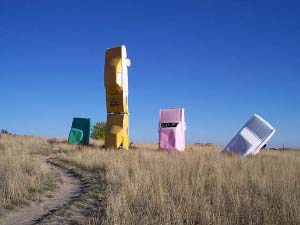 Carhenge
former resident, James Reinders, who wanted to build an American version of England's Stonehenge.
Carhenge
former resident, James Reinders, who wanted to build an American version of England's Stonehenge.
Just north of Alliance Nebraska, on the other side of the town from the busy train tracks, we found Carhenge this morning. It is the creation of a  Carhenge
former resident, James Reinders, who wanted to build an American version of England's Stonehenge.
Carhenge
former resident, James Reinders, who wanted to build an American version of England's Stonehenge.
In fact, from a short distance, the similarity is striking, especially in the morning when the sunlight turns the structure into a grey silhouette. The cars have been covered in thick grey paint, a bit weatherworn now that Carhenge is over twenty years old. We were the only visitors at eight o'clock on a fall morning, and happily wandered around, photographing the art from various angles. Some not inconsiderable engineering skill, not to mention quite a bit of welding, has been used to place these cars in these apparently precarious positions, yet have them withstand years of prairie weather.
We walked around and around, noting the shadows cast by the morning sun, curious as to whether this Nebraska look-alike could be used for  The Fourd Seasons
astronomical purposes, such as pinpointing the autumnal equinox. The story board at the parking lot next to the highway showed that these modern Cornhusker Car-Architects had knowledge of the earlier English features.
The Fourd Seasons
astronomical purposes, such as pinpointing the autumnal equinox. The story board at the parking lot next to the highway showed that these modern Cornhusker Car-Architects had knowledge of the earlier English features.
Away from the central ring of buried car-o-liths are other welded vehicular art forms, include the colorful Fourd Seasons, a dinosaur skeleton, and a most alluring green salmon, caught in the middle of a spawning upstream leap. Carhenge is highly recommended by Bob and Elsa.
We were scarcely away from Carhenge when the driver put on the brakes and made a country U - turn, directing the photographer to capture another, smaller roadside attraction. It was a Nebraska prairie Rest Stop, consisting of bales of hay tastefully surmounted by an easy chair and a toilet.
 Tyrannosaurus Rex?
Tyrannosaurus Rex?
Near Alliance, the road travelled through fertile farmland; in addition to the corn, milo, beans and hay, we saw fields of sunflowers and sugar beets (we're pretty sure). The beets were being harvested, this morning, brought by the truckload to roadside weigh stations, dumped by a conveyor on the ground, soon to be reloaded and taken to a sugar plant somewhere in the prairie.
But as the day progressed the land grew higher and dryer, punctuated by buttes and mesas, too rough for plowing. We were entering cattle ranch land. Each ranch seemed to have about a square mile of prairie. The ranch buildings could be spotted from miles away, little patches of green trees and domestication amid the uncountable acres of yellow-brown grassland.
We soon learned we weren't in Nebraska anymore. Wyoming greeted us with tiny, tiny towns. Lost Springs which once had hit 300 as a mining town,  Roadside Rest?
was greatly shrunken. The guide book waffled as to whether Lost Springs (pop.6) was the smallest incorporated town in the West -- evidently there are other contenders for the honor. But as we drove by, we could see that civic pride was at work. The bright green town sign, put up by the state after the 2000 census, recorded the population of Lost Springs as just 4.
Roadside Rest?
was greatly shrunken. The guide book waffled as to whether Lost Springs (pop.6) was the smallest incorporated town in the West -- evidently there are other contenders for the honor. But as we drove by, we could see that civic pride was at work. The bright green town sign, put up by the state after the 2000 census, recorded the population of Lost Springs as just 4.
The tourism motto of Wyoming is "Cowboy UP" and so -- of course -- we soon saw cowboys guiding a herd of Angus cattle to a corral. We waved and they waved back. People are still very friendly.
These days the buffalo are all in domesticated herds, and the deer (many of which are relative newcomers to the western prairie) only play at night. But all along the road from Douglas to Casper we saw herd after herd of antelope browsing contentedly. We fervently hope we Americans will always enjoy the sight of these graceful animals along the roadsides.